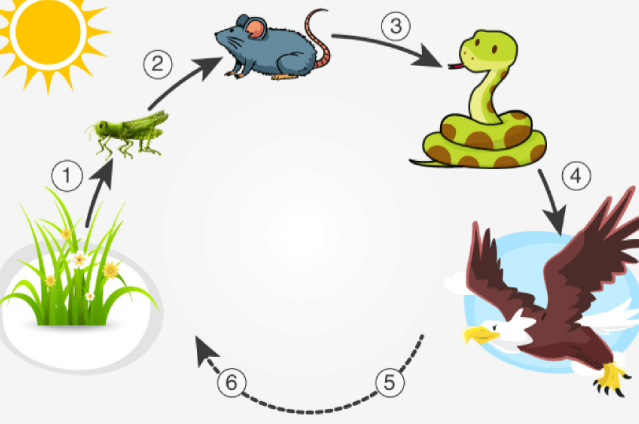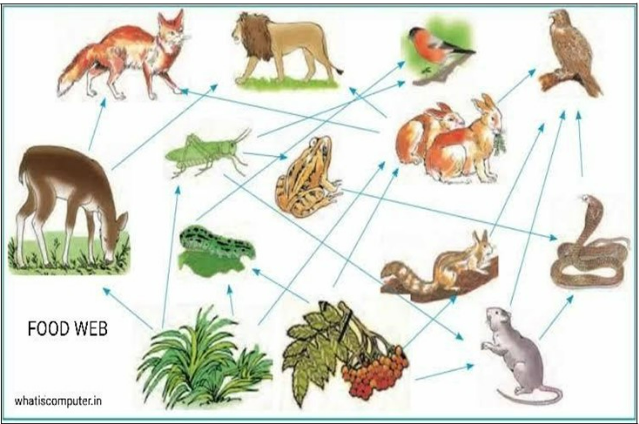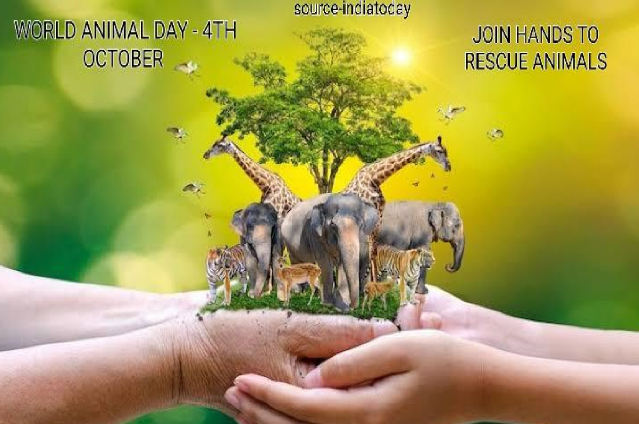Animals are part of earth far earlier than human beings so we can say animals are real creatures of earth's environment. They can nurture the environment without human beings but humans can't survive without animals. But these beautiful species are disappearing far more rapidly than expected and this can create a threat to our environment as well as human's existence. As we can see the following energy pyramid which shows how the energy from the sun is absorbed by a large number of plants and transmitted to a comparatively lesser number of primary consumers which are herbivores. These primary consumers get served as food to secondary consumers and transmit the energy. In the same manner, the tertiary consumer intakes secondary consumers as its food and absorbs a larger part of energy than secondary one's. This is how animals balance the environmental energies and keep our environment alive and make it worthy of living for mankind.

Each living thing in an ecosystem is part of multiple food chains.Food chain is a linear sequence of organisms which starts from producer organisms and ends with decomposers. This food chain shows us the process of how the producer i.e. the plant is eaten by a grasshopper then the mice eat the grasshopper. The snake feeds on mice and the eagle eats that snake. When the eagle dies, fungi breaks down and turns into nutrients and those nutrients along with sun and water cause the grass to grow and this is how one food chain gets accomplished.

Here is a food web that shows us a system of interlocking and interdependent food chains. This demonstrates how the animals feed on one another and balance our ecosystem as well as keep their numbers in limits. But due to our actions we are getting these numbers destorting and unbalancing.

Here are some figures of worldwide animal population available which shows us how we have reached this population at the verge of extinction due to the fulfillment of our personal selves.
According to surveys, we are left with only 674 asiatic lions in India (as per 2019 census) and only around 20,000 in the whole world as per census 2020. Similarly, the number of elephants is 497000 all around the world as per census 2020-21. The reindeer population has also declined by 56 percent and we are left with only 3.7 million as per the 2021-22 census. There are now a total of 41,415 species on the IUCN Red List, and 16,306 of them are endangered species and threatened with extinction. However some species of animals have been categorised as endangered are as following:
- Javan Rhinos…Only 67 Javan rhinos are currently estimated to remain in the world, making this critically endangered rhino species one of the most threatened large mammal species on Earth.
- Snow Leopard…There are an estimated 4,080-6,590 snow leopards in the wild, but it is difficult for scientists to know for sure.
- Sunda Island Tiger… It is estimated that there are only 3,500 tigers remaining in the wild worldwide.
- Mountain Gorillas…For decades, mountain gorillas have been subjected to uncontrolled hunting, disease, habitat loss and the ravages of human conflict. Their numbers plummeted, and they are now considered endangered.
- Orangutan…The destruction and degradation of the tropical rainforest, particularly lowland forest, in Borneo and Sumatra is the main reason orangutans are threatened with extinction.
These rapidly decreasing numbers alert us to get the animal rescue and nurture programs into effect if we want to save ourselves and our planet.
To rescue animals we can be part of any shelter home or can provide a foster home to an animal. Nowadays, the government has set some standards to care for animals. Some are the following:
- There should be no closed cage for an animal to shelter.
- There should be proper medical checks in case any sickness symptoms arise.
- Any kind of violence against sheltered animals will be punishable.
- Their living area must be cleaned with chlorine bleach.
- They must have their food pans or hay stocks.
Apart from these, the restrictions have also been imposed on animal poaching and trafficking to rescue the animals. According to
Indian Penal Code, 1860: Section 428 and Section 429 reads that killing, poaching, maiming, poisoning or torturing an animal is a cognizable offence. Offenders can be reported to the local animal protection group and police station and a case filed under the above-referenced sections. Punishment is a fine of Rs 2000 and/or a jail term of up to five years.
Global animal welfare partnership organization has set a 5 step standard for animal welfare.
What are the five welfare needs of animals?
- They should live in a suitable environment.
- They must eat a suitable diet.
- They exhibit normal behavior patterns.
- They should be housed with, or apart from, other animals.
- They must be protected from pain, suffering, injury and disease.
The Indian government as well as many world wide organizations like PETA, PEOPLE FOR ANIMAL, BLUE CROSS ETC are raising funds to rescue animals and campaigning to educate people about animal rights. Every year we celebrate "World Animal Welfare Day" on the "4th october". The day was first observed on March 24,1925. This year the theme of the day is "Why & When: protecting and providing shelter towards animals and taking care of them".
The objective of World Animal Day is ensuring rescue shelters for the animals, raising funds, launching animal welfare programs and conducting activities to spread awareness in coming generations so that they can be a part of this campaign. In many schools, posters of animal cruelty, ways of animal rescue are created to have a better understanding of the scenario. We must teach our children the need of animal rescue for a balanced ecosystem and encourage them to steps forward for this agenda.

The children will be the coming youth and once we rope the seed of animal welfare in their mind at this age, tomorrow they will be ready to face the challenges and will be able to take the necessary steps in this direction.
